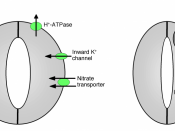Transpiration is the process that allows plants to release H20 in the form of water vapor into the atmosphere. This process mostly occurs during the time the stomata, the microscopic pores on the surface of a leaf, are open for the passage of CO2 and O2. Transpiration plays a huge role for plants, as 90% of the water that enters the plant is through transpiration. It also allows the plant to receive key nutrients and minerals in order to survive. By transpiring, or evaporating, it causes the plant to suck up more water from its roots, causing a constant flow of water through the plant, which is optimal for survival. If transpiring were to terminate, then the plant would continue to evaporate, while water is not being drawn from the roots to circulate through the plant. This will cause the plant to wilt and die. It also allows to plant to regulate its temperature, which is especially important when environments are constantly transforming.
In fact, transpiration can lower the temperature of the leaf by as much as 10-15 degrees Celsius from the surrounding area. Water is vital to plant life, not just for turgor pressure reasons, but much of the cellular activities occur in the presence of water molecules and the fact that the internal temperature of the plant is regulated by water.
Transpiration begins as water is drawn up from the soil through the plant roots. These roots are covered with millions of tiny root hairs, which have large surface areas so that the plant may absorb enough water into its system from the soil. Water may also be absorbed into the roots through osmosis. Water travels up from the roots, through the plants, and to the leaves. The water is carried by tubes called Xylem vessels, which have...


